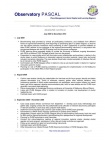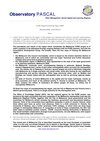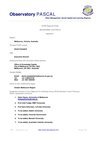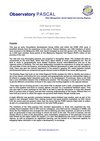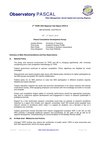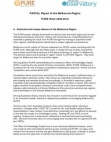Melbourne City, Australia
The boundaries and nature of the region which constitutes the Melbourne PURE project is in itself a question to be addressed through ongoing dialogue with the PURE partners, and with the Consultative Development Group. Put broadly, there are four ways of framing the Melbourne region:
- the Melbourne City Council municipality, which is based on the Central Activities District of Melbourne, and in which six universities (and one major Technical and Further Education College) have some kind of physical presence;
- the metropolitan region of Melbourne, best represented in the work of the state government in its planning statement, Melbourne 2030;
- the Melbourne ‘commuter zone’, encompassing Geelong in particular, Ballarat, Bendigo, western Gippsland and a series of peri-urban municipalities which surround the metropolitan area. The nearby city of Geelong is Victoria’s second largest city and is effectively integrated with Melbourne as a single economic and social entity, while also having its own significant manufacturing and service industries. Other large provincial cities, such as Ballarat and Bendigo, are closely linked with the metropolitan area as well as servicing regional needs; and
- the state of Victoria, of which Melbourne is the capital and the major metropole, insofar as most economic and much of the political activity in Victoria is centred on Melbourne. The State contains five million of Australia’s 20 million people. Of these, 3.5 million live in metropolitan Melbourne.
Of these four ways of conceptualising the region, only the City of Melbourne and Victoria have a distinct governing body. There is no single authority for the metropolitan area.
The Office of Knowledge Capital (OKC), the key regional agency for the PURE project, was formed by the eight universities that have campuses in the Melbourne metropolitan area (see the Melbourne Regional Profile), together with the City of Melbourne (local government) and the Committee for Melbourne (which includes key business, government and educational leaders). However, three of the universities have significant campuses in parts of country Victoria, while three others each have an active rural presence. There is a ninth university in Victoria, the University of Ballarat, and a further seventeen TAFE colleges, of which there are three large colleges in metropolitan Melbourne. In recognition of some of these complexities, the OKC has taken steps to establish another network, ‘CHUM’: Councils Hosting Universities in Melbourne, that would facilitate collaboration amongst local governments, not only Melbourne, with respect to their relationships with universities.
 Printer-friendly version
Printer-friendly version- 96 reads

